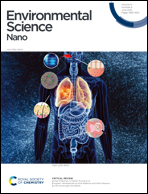Metal-doping of nanoplastics enables accurate assessment of uptake and effects on Gammarus pulex†
Abstract
Because of the difficulty of measuring nanoplastics (NP), the use of NPs doped with trace metals has been proposed as a promising approach to detect NP in environmental media and biota. In the present study, the freshwater amphipod Gammarus pulex were exposed to palladium (Pd)-doped NP via natural sediment at six spiking concentrations (0, 0.3, 1, 3, 10 and 30 g plastic per kg of sediment dry weight) with the aim of assessing their uptake and chronic effects using 28 days standardized single species toxicity tests. NP concentrations were quantified based on Pd concentrations measured by ICP-MS on digests of the exposed organisms and faecal pellets excreted during a post-exposure 24 hour depuration period. Additionally, NP concentrations were measured in sediments and water to demonstrate accuracy of NP dosing and to quantify the resuspension of NP from the sediment caused by the organisms. A significant positive linear relationship between the uptake of NP by G. pulex and the concentration of NP in the sediments was observed, yet no statistically significant effects were found on the survival or growth of G. pulex. A biodynamic model fitted well to the data and suggested bioaccumulation would occur in two kinetic compartments, the major one being reversible with rapid depuration to clean medium. Model fitting yielded a mass based trophic transfer factor (TTF), conceptually similar to the traditional biota sediment accumulation factor, for NP in the gut of 0.031. This value is close to a TTF value of 0.025 that was obtained for much larger microplastic particles in a similar experiment performed previously. Mechanistically, this suggests that ingestion of plastic is limited by the total volume of ingested particles. We demonstrated that using metal-doped plastics provides opportunities for precise quantification of NP accumulation and exposure in fate and effect studies, which can be a clear benefit for NP risk assessment.



 Please wait while we load your content...
Please wait while we load your content...